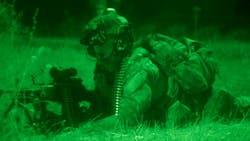Army reaches out to industry for identification-friend-or-foe (IFF) sensors to help infantry fight at night
NATICK, Mass. – U.S. Army researchers are surveying industry for companies able to design and build small, lightweight wearable identification-friend-or-foe (IFF) sensors to help infantry soldiers fight safely at night.
Officials of the Army Combat Capabilities Development Command Soldier Center (CCDC SC) in Natick, Mass., issued a sources-sought notice last week (W911QY-20-IFFDEVSOLUTIONS) for the Identification Friend or Foe (IFF) Integrated Verifiable Technology for Combat Clothing and Individual Equipment project.
Army researchers are looking for technologies that provide covert, secure, and verifiable IFF capabilities that infantry soldiers can wear. These technologies not only should minimize size, weight, and power (SWaP) usage, but also should be covert, authenticated, integrated, or detachable, and be compatible with the electromagnetic spectral range of military clothing.
The IFF system should be integrated into, or be removable from, the clothing and individual equipment of the foot soldier. It should have a military-relevant color for camouflage, and be no larger than nine square inches.
Related: Army reaches out to industry for transponder technology to separate friend from foe
IFF sensor technologies should be located on the soldier's head or upper torso, and provide at least 270 degrees of detectable coverage. It must minimize detection by common night vision goggles, and minimize light transmission.
IFF sensors help U.S. and allied fighting forces quickly discern friend from enemy in the often-chaotic environment of nighttime combat, and help avoid friendly fire incidents.
The system's use should not give away the location of friendly forces during scanning or detection, and have peak performance from sunset to sunrise. The minimum detection distance should be 328 yards.
Companies interested should email five-page concept papers to the Army's Mary Prebensen no later than 7 June 2020 at [email protected] and to Denise Tolliver at [email protected].
Papers should describe the IFF technology, development approach, and military relevance; any past performance with development of similar technologies; and estimated project cost and unit price.
Email questions or concerns no later than 31 May 2020 to Mary Prebensen no later than 7 June 2020 at [email protected] and to Denise Tolliver at [email protected].
More information is online at https://beta.sam.gov/opp/bf8a391d17b54689a46e621414683e3a/view.

John Keller | Editor-in-Chief
John Keller is the Editor-in-Chief, Military & Aerospace Electronics Magazine--provides extensive coverage and analysis of enabling electronics and optoelectronic technologies in military, space and commercial aviation applications. John has been a member of the Military & Aerospace Electronics staff since 1989 and chief editor since 1995.

